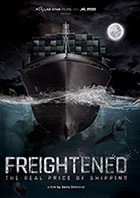
Freightened: The Real Price of Shipping 2016
Distributed by Green Planet Films, PO Box 247, Corte Madera, CA 94976-0247; 415-377-5471
Produced by Polar Star Films
Directed by Denis Delestrac
DVD , color, 52 min.
College - General Adult
Business, Economics, Ecology, Extinction, Foreign Trade, Government, Politics
Date Entered: 12/20/2016
Reviewed by Michael J. Coffta, Business Librarian, Bloomsburg University of PennsylvaniaThis scathing work explores both the mechanics and impact of the global shipping industry, as approximately 90% of consumer goods are shipped by nearly 60,000 goliath vessels. It begins with an economic assessment of the industry, demonstrating exactly why shipping has become so cheap, and why the world’s economies are dependent upon this low cost. To this end, the shipping industry has increased the size of its vessels to the point that they are too large to enter conventionally sized harbors, has integrated itself into enforcement agencies, and exploited loopholes in regulations. For example, ships may be registered for a country of origin, such as the land locked Mongolia, to qualify for certain leniencies and/or exemptions.
The second portion of the film focuses on the environmental impact of current shipping practices. Hazardous practices such as ballast water release and degreasing gravely affect the oceans, but regularly go undetected by authorities or the media. The film skillfully exposes many of the not-so-obvious consequences of shipping, such as low-frequency noise pollution from ships’ engines causing mass whale beachings. Next, this work examines ships’ use of incredibly low grade fuel, and its toll on local and global air pollution. Simply put, this work touches the air, noise, and water pollution caused by large scale freight ships. It concludes with a rather lengthy framework for retooling the industry in terms of regulations, labor, and environmentally friendly technologies.
This is a profoundly troubling work. It unquestionably makes the viewer pause and contemplate the factors of product pricing. Despite its alarmist tone, it emphasizes the amount of time needed and economics consequences of reforming the industry. A distinct feature of this film is that it becomes implicitly apparent that it only scratches the surface. There are missing details concerning operations of harbors and shipyards that the director was prohibited from recording.
Freightened has high production values, with terrific use of CGI elements, such as maps, to accentuate points. This work is to be applauded for dissecting what it rightly calls an “invisible,” yet ubiquitous, industry.